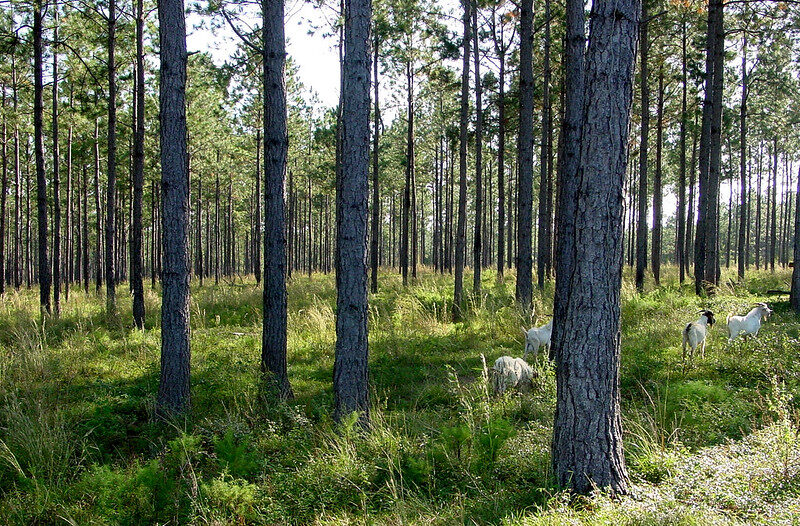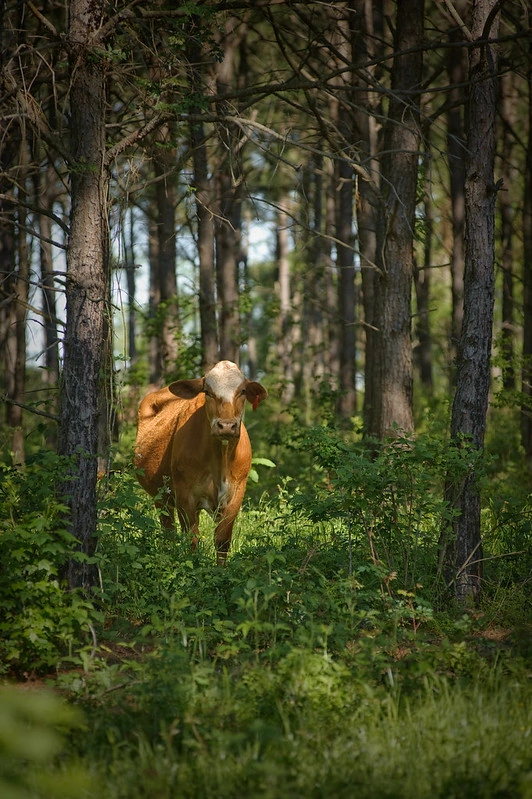This article was originally copublished by Nexus Media News and Ambrook Research.
On a clear morning in April, after milking his seven cows, Tim Sauder looked over the pasture where he had just turned the animals out to graze. Like many dairy farms, Sauder’s fields swayed with a variety of greenery: chicory, alfalfa and clover. But they were also full of something typically missing on an agricultural landscape — trees. Thousands of them.
Between 2019 and 2021, Sauder planted 3,500 trees at Fiddle Creek Dairy, a 55-acre family farm in Lancaster County, Pennsylvania, where he and his wife raise cows to produce yogurt, cheese and beef. Today, young willow, hickory, poplar, pecan and persimmon trees stud the pastures, and on a crisp spring morning, rows of honey and black locusts, bur and cow oaks, were beginning to leaf out, casting shadows on the long grass below.
Sauder said planting trees has always been a priority; before he filled his pastures with them, the farm was home to a small fruit orchard as well as riparian buffers — trees planted along the creek to prevent erosion and safeguard water quality. But the trees that his cattle now graze beneath represent a fundamental shift in his operation.
The Sauders are betting the farm, as it were, on silvopasture, the ancient practice of raising animals and growing trees and pasture on the same piece of land (silva is forest in Latin). In a silvopasture setup, farmers carefully manage each element to benefit the other — relying on manure to fertilize trees, for example, or fallen fruit to feed the livestock — resulting in a system that’s greater than the sum of its parts.
It’s an old idea that’s gaining modern traction. Last year, the USDA awarded the Nature Conservancy and multiple partner organizations a $64 million grant to advance agroforestry — the umbrella term for agricultural practices that incorporate trees — by providing technical and financial assistance to farmers looking to make the switch. This year’s Farm Bill could mean another infusion of funding as well as the expansion of existing agroforestry programs to more explicitly include silvopasture.

“The USDA is doing a lot, but a lot more could be done,” said Jacob Grace, communications project manager with the Savanna Institute, a nonprofit that promotes agroforestry practices. His organization is advocating that the 2023 Farm Bill increase appropriations for the National Agroforestry Center, the only government agency dedicated to the practice, from $5 million to $25 million (Grace said the Center has been chronically underfunded, never receiving more than $2 million annually). They’re also pushing for the establishment of regional agroforestry centers, the development of a USDA technical assistance program in agroforestry, and more grant money dedicated to helping farmers like Sauder establish a silvopasture system.
In Sauder’s pastures, “each tree has multiple benefits,” he explained. Mulberry leaves have more protein than alfalfa, and the seed pods that fall off the honey locust every autumn are packed with sugar; those trees were chosen to supplement the animals’ diet. Sauder chose other tree species with leafy canopies to protect his herd’s health. “Come August, there will be shade here when the cows need it.”
Providing shade may seem like a matter of comfort, but it can actually be one of life and death. Last summer, thousands of cattle died in Kansas, after the area was racked by historic heat and humidity. As the climate heats up, researchers think mortality events like the one in Kansas will become more common. But even when cattle survive brutally hot summers, the impact of heat stress can wreak havoc on a farm’s bottom line.
Crushed by negative news?
Sign up for the Reasons to be Cheerful newsletter.Grace said the farmers he works with are worried about what hotter temperatures mean for their livelihoods.
“When we talk to our producers about silvopasture, the first thing they’re interested in is shade,” Grace said. “They’re noticing the hotter temperatures. Their cattle are uncomfortable, they’re not putting on weight. Cash is almost directly flowing out of that farmer’s pocket when they have overheated cattle.”
A lot of cash, in fact. A 2022 study from Cornell University predicted that losses of cattle herds due to heat stress will total $15 to $40 billion a year by the end of the century. To avoid these losses, the authors note that “tree–livestock systems can be highly effective in reducing heat stress.” And Farm Bill funding could help more farmers get started.
Shade is one way silvopasture cuts down on costs, but there are others. Some poultry farmers use the method to shield their flocks from birds of prey. Vineyards and Christmas tree farms are increasingly turning to grazing animals to mow and control weeds.
But a silvopasture system can do more than simply save farmers money; it can help them diversify what they grow. Perhaps one of the oldest — and most profitable — examples of silvopasture is the dehesa system of southern Spain, where Ibérico pigs wander among towering oak trees, feasting on acorns and fertilizing the soil, resulting in some of the world’s most expensive ham and a cash crop of cork.
While livestock health and revenue are compelling reasons for farmers to practice silvopasture, perhaps the method’s most convincing advantage is its potential as a climate solution.
Project Drawdown, a nonprofit that analyzes climate solutions, ranks silvopasture as the 11th most effective strategy for combating climate change — well ahead of solar panels, recycling and electric cars — finding that pastures with trees sequester five to 10 times as much carbon as similarly sized but treeless pastures.

The perennial roots of a silvopasture system can also help stabilize the soil, preventing erosion as well as the flooding that’s becoming more common with heavier rains. Additionally, a well-managed silvopasture operation can reduce wildfire loads — thanks to carefully spaced and pruned trees as well as grazing animals that control the shrubby understory — and increase biodiversity.
What’s more, when livestock get to eat the forage that’s right in front of them, the gas-guzzling farming equipment and trucks typically used to get food to feedlots can stay in park. “Cutting back on harvesting and transporting means a significant reduction in greenhouse gasses,” Grace explained.
According to Grace, large swaths of the American Midwest used to be covered by a natural silvopasture of sorts, an oak savanna ecosystem where grazing animals like bison dined on prairie beneath fruit and nut trees. Many Indigenous cultures embraced and benefited from this form of land management, until European settlers got to work deforesting the region, eventually building farms that worked more like factories.
This emphasis on efficiency led to widespread monoculture and annual cropping systems where, Grace said, “for a good chunk of the year, not much is happening.”
Today, only about 1.5 percent of farmers in the U.S. (approximately 31,000) practice any form of agroforestry, including silvopasture, a 2017 USDA survey revealed. But as summers get hotter and climate predictions more dire, interest in the practice is booming. Matthew Smith, research program lead at the USDA’s National Agroforestry Center, said “the demand for silvopasture knowledge and information is higher than anyone can provide.”
That’s because silvopasture is more complicated than turning livestock loose in the woods; it requires choosing the right trees and forage for the local climate and constantly moving livestock from one place to another.
“If folks are interested in silvopasture, they really should have expertise in rotational grazing beforehand … which is hard to learn,” Smith said. “Things can go wrong quickly when all your crops are in the same place.” Livestock left in one spot too long can damage trees, for example, and plants grown too close together can outcompete each other for light and nutrients.
There are other challenges. For one thing, silvopasture systems require a large area of land and more hours of labor — at least at first — to maintain. Additionally, it takes trees many years to grow and begin to provide meaningful benefits. But, by far, the greatest obstacle for most farmers who want to practice silvopasture is the high price of purchasing, planting and maintaining trees.
The vast majority of silvopasture operations rely on grants and cost-sharing programs from organizations like the Natural Resources Conservation Service and the USDA, programs that advocates like Grace say badly need the boost in funding and staff that this year’s Farm Bill could provide. Grace said that the handful of existing agroforestry programs, such as the Conservation Reserve Program and the Environmental Quality Incentives Program, are vague in their wording and need to be tweaked to more explicitly fund silvopasture projects and provide additional cost-sharing opportunities to farmers.
Savanna Institute ally and climate NGO Carbon 180 is recommending that the 2023 Farm Bill increase federal cost share to 75 percent for agroforestry practices to help defray upfront costs and ensure farmers can access high-quality, regionally appropriate trees and shrubs.
In the meantime, funding remains a “major barrier to farmers hoping to pursue silvopasture,” said Austin Unruh, owner of Trees for Graziers, who helped Tim Sauder secure money from the Pennsylvania office of the NRCS. Unruh, whose business has helped about 25 farms implement silvopasture in the last three years, said helping farmers pay for them “has been frustrating. It’s a different source of funding each time, different hoops to jump through.”
For Sauder, the financial assistance from the state was paramount. He said that without it, the trees in his pasture simply wouldn’t be there, “at least not for the next 20 years or so.”
He admits that the new system has been a lot of work upfront, but that he expects it to pay off in the form of healthier pasture, soil and cows — and hopefully his land’s ability to support more of them.
And yet, it’s working in tandem with nature that inspires Sauder the most. Running his farm with the health of the ecosystem top of mind, he said, is like making up for the mistakes of his ancestors, Mennonite immigrants who displaced Indigenous people and bent the land to their will.
“I’m reimagining what would have happened if they had arrived here and said instead, ‘What’s the best way to live in this place?’”








